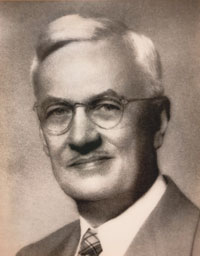What is an Actuary?
How the first SOA president defined the profession
October/November 2018
About Edmund M. McConney, FSA
“Mac” McConney was born on Nov. 11, 1891, on the island of St. Kitts in the West Indies, where his father was a minister in the Anglican church. McConney’s father tutored him until he went to Harrison College in Barbados, where he graduated with honors.
In 1911, McConney emigrated to Toronto, Canada, and went to work for the Manufacturers Life Insurance Company. His insurance career was interrupted in 1914 when he enlisted in the Second Canadian Division and served in France for four years. Upon returning to civilian life, he joined the Bankers Life Company in Des Moines, Iowa. He began his career there as assistant actuary in 1920, rising to president in 1946 until his retirement in 1956. He continued to serve as director until 1967.
Active in Des Moines civic affairs, McConney was chairman of the board of trustees of Drake University, president of the Edmundson Art Foundation and president of the Greater Des Moines Chamber of Commerce. He received an honorary Doctor of Laws degree from Drake University in 1952.
1949
The first president of the Society of Actuaries (SOA), Edmund M. McConney, FSA, put it this way in 1949:
The actuary in reality is a sound, practical—rather a too theoretical—mathematician applying simple principles of probabilities to human affairs in the unknown future. He applies what facts he has to such unknowns as future mortality and morbidity rates, constantly changing for better and for worse in a scientific world of rapid development in medical research … and of atomic bombs; future interest earnings under government controls and what is left of free enterprise; future expenses under ever-changing money values; and future human emotions in regard to security, savings and family needs in a civilization that is meeting, with some difficulty, the challenges so well described by [Arnold] Toynbee.
It is the unfamiliarity with the rather simple principles involved in these calculations, rather than inherent difficulties in the mathematics, that has led even intellectually competent people to invest the process with some magical quality.
Meanwhile, the actuary “enjoys” a high reputation as a mysterious authority on the complexities of mathematics, living in an intellectual atmosphere beyond ordinary reach. He gains, therefore, some glory reflected from those “Einstein-ian” realms—but, as he surveys his roughly sculptured approximate formulae, he may wonder if they are not rather “Epstein-ian,” and as he reiterates over and over again his theme of mortality, morbidity, interest, expenses and emotions, he may become somewhat “Gertrude Stein-ian.”1
Oh, how times have changed! Tweet your definition of today’s actuary to @SOActuaries, or email your definition to theactuary@soa.org. We’ll share the different viewpoints on our social media channels.
The SOA is rich in history. “TIMELESS” is intended to reveal some of that history and offer the past as a lens for the present. McConney’s description of an actuary is nearly 70 years old—the use of male pronouns was a sign of the times in 1949. Today, the SOA best fulfills its mission when it is diverse and inclusive of all individuals (and pronouns). Read more about SOA diversity and inclusion efforts.
References:
- 1. Greb, Richard. 1999. The First 50 Years: Society of Actuaries 1949–1999, 9–10. Schaumburg, IL: Society of Actuaries. ↩
Copyright © 2018 by the Society of Actuaries, Chicago, Illinois.

